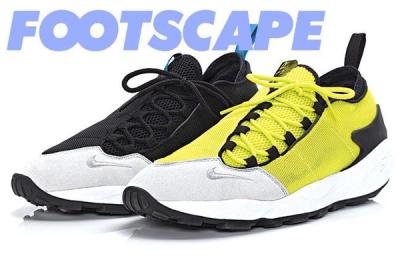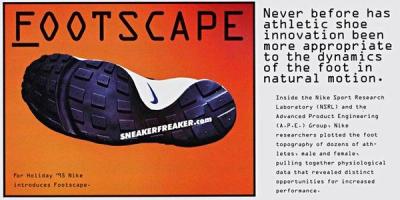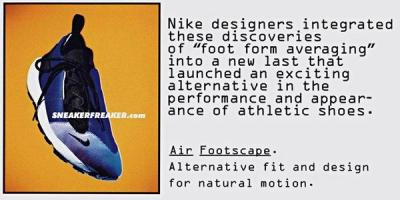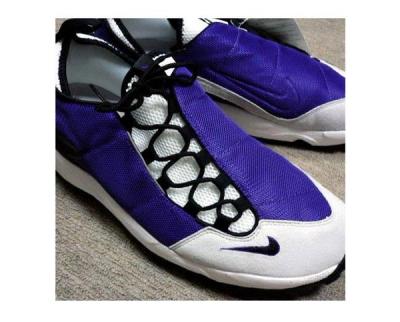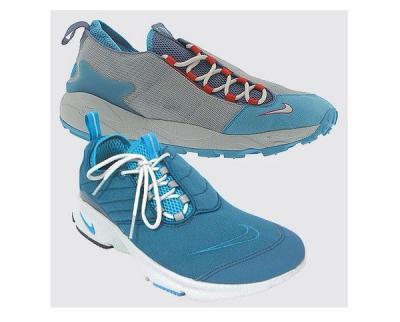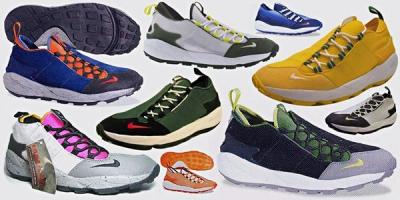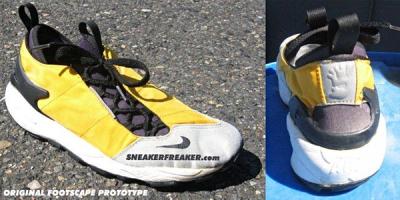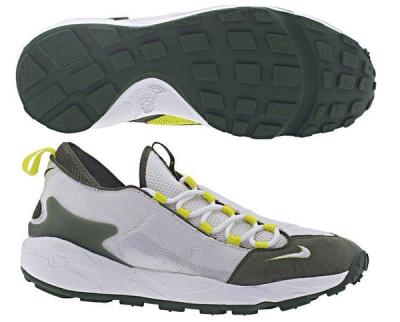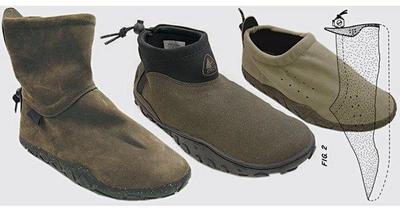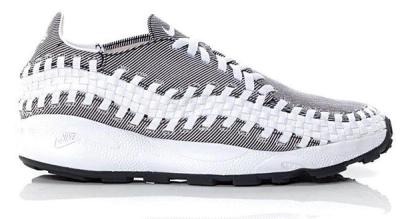The Nike Footscape
In the nineties Nike produced some of its most exciting and visually striking footwear. Two models in particular, the Footscape and the Moc, have remained favourites among sneaker aficionados and are still in production, having been made in numerous colourways. Tory Orzeck was involved in the design of both of these twisted models - Here's what he had to say about them...
Hey Tory, what was your role at Nike?
I worked at Nike from 1991 to late 1995 in the Advanced Project Engineering Group, or APE. APE was made up of a handful of engineers and designers. Our charge was to upset the status quo. I am sure my bosses thought I was a huge pain in the rear end, but I didn’t care as I was going to pursue what I wanted. Man, I was a pain! It was brilliant because I did not care!
How exactly did the Footscape project come about? I read it involved scanning thousands of people’s feet to create a new shape for running shoes. Can you elaborate on that?
When I first joined APE we were given dopey, almost-engineering projects, but, like I said, I hadn’t just moved across the country to determine what the best adhesive was or how many perfs you need to put into a basketball shoe upper. I created vehicles or shoe ‘showcars’ to demonstrate the innovations. I think Nike recognised I could identify opportunities so I remember they let us propose projects. I knew that Birkenstocks were coming back into fashion and I also understood that the last (the thing shoes are built on) is part-anatomy and part-art. I proposed doing a real Footform running shoe. Later, the higher-ups announced this was a project I could pursue. We did cast many men’s and women’s feet, not quite in the thousands, but a scientific journal respectable number. I also had been a cross country runner in high school and I ran in Nike LDVs and raced in Nike Elites. I loved the Elite and how it was just a simple nylon pack cloth upper. I also loved the imagery that Nike used during my cross-country years. Do you remember the Nike LDV poster of the athletic hippies sitting at the foot of a mountain peak?
I had just come from GE Plastics and we strived to make products with as few parts as possible. Nike was almost the opposite, so I was keen on making the Footform shoe simple like the old Nike Elite. I wanted to make it visually less complex than the mess many athletic shoes are. Contextually, I wanted it to visually jump off the shoe wall. I was aware of the burgeoning outdoor market and wanted the materials to reference those materials, simple pack cloth (I have a prototype!). I am not so in love with the commodity/factory mesh, although its breathability is awesome. I got trumped!
When the Footscape, the Rift and the Air Max ‘95 dropped, all of a sudden it felt like Nike kicked into another gear and started dropping bombs again. What was it like working there at the time?
At first it was amazingly fun. I had a boss who was not a designer and, like I said, I think I knew more than him what would turn people on to what APE was doing. He was a good guy but if he told me to stop I just went direct to Mark Parker (head of R+D then, now a president) and told him how great a particular thing was. Sure enough my stuff would be back on track. This boss and I had our moments but I totally respect him and had more fun than I ever have. Dave was completely a champion for our group! The Air Rift came from a brilliant model maker, Kip Buck. I felt like there were few boundaries. We lived for the product! My next boss was a designer, who was very smart but not quite as supportive. He seemed to feel the reality of being torn between being supportive of his APE group and bowing to his bosses. Let’s just say there is a lot of ego at Nike and it feels like a huge success to have innovative/risky products come out. It also seemed like Nike was adding layers of bureaucracy as time went on. I totally agree that many innovations happened during this period.
An engineer named John Tawney and I invented the Fomposite (I named it and it stuck) while we were working on an advanced basketball shoe. He had come from Ford and me, with my GE background, wanted to make a product that took less labour. Of course we presented it as a lightweight high performance product, which it was. The current Nike Free technology was invented by Mike Aveni back during this period as well or at least Mike did a similar product. The great thing about Nike is that there are lots of great ideas behind the berm, but it’s a question of the right timing, or alchemy in the air, that kicks something out. So, as a designer, you may not know what had happened a few seasons earlier. I think this serves Nike well. As a concept, with multiple validators, it may prove to be a great one.
Did something change, or was it just fashion turning back to Nike whilst you kept doing what you’d always been doing?
Well, I left Nike in July 1995, but I am aware of the ‘familiarity breeds contempt’ phenomenon that successful companies must deal with. Consumers, especially kids, are fickle. They, myself included, want the hard-to-find, the unique.
The side-lacing feature was probably the biggest innovation to feature on the shoe and was immediately ripped off by virtually every casual shoe company on the planet. What was the reaction when you first showed your sketches?
The first reaction was as you might expect. Something like, ‘Wow that’s cool,’ in the ‘different is better than good’ reality most people have. The first time I showed it at a big meeting I referenced how side-lacing was used in orthopaedic shoes. One of the higher-ups chided me that Nike does not make ‘orthopaedic’ products, ‘We are about performance.’ Of course! But any design for the handicapped generally benefits able-bodied people as well. Needless to say, I changed my pitch. When you understand the function and benefits it’s a solid concept.
What was the logic to developing a side-lacing shoe?
My thinking was simple. This was a product built on real anatomy so whatever I can do to make this running shoe as ergonomic as possible I will do it. I had seen orthopaedic shoes with side-laces prior and I did a little research as to the benefits. If you look at human foot anatomy there are major arteries and nerves superficial to the dorsal surface of the foot. Moving the laces to the lateral side takes the point loads caused by the laces away from these more vulnerable anatomical structures. Additionally, it is difficult to distinguish a Footform shoe compared to conventional in the 3/4 view. The Footform shoe only subtly reveals itself in the top view.
What do you think is its aesthetic appeal?
It looked radically different and if you have tried them and they fit (running shoes are prescriptive), they are amazingly slipper-like. I think their simplicity really comes through. There are a minimum of layers. Again, it’s the context. They jump compared to the visual cacophony inherent in other running shoes. I think the nature of aesthetics is such that we are attracted to the different. Here’s my Ali G logic: imagine you can be with Elizabeth Hurley (and we all know she is amazing), but after a few years you are used to her beauty so when Cameron Diaz shows up you're like, ‘Who is that? She is so beautiful!’ And you’re off chasing Cameron, even with her acne.
I loved the colourways that were chosen for those first series. They were nothing like what you expected from a Nike running shoe of that era; the black/red Fall colourway after the blue/grey first colour, then the Mystic Teal (best colourway name ever and that was just the men’s). Did you have much input to the colours?
I agree with you, the Mystic Teal is nice. I proposed colours and I liked simple, almost like VW-new-beetle-simple, but Nike has a big department dedicated to exploring the colourways. Marketing approves the final deal. Also, colourways are unique for different geographic regions. I think the later releases were more adventurous.
Nike’s used the Footscape for striking press ads launching that year’s range, was that the first time you got external feedback that this could be a ‘special’ shoe?
Man, I totally want to see what you have seen. The ones in the US were just a beauty shot of a single shoe.
Side-lacing now seems to have become de rigeur for football boots. As a designer, do you get a sense of satisfaction from seeing something you pioneered on people’s feet every day?
Yeah, it’s funny because the Footscape was almost killed as being too risky but a few of us rallied to show how acceptable it could be.
The sales samples and all the press featured the first colour of the Footscape with a smooth black sock liner whilst the final release version had that replaced with white waffle mesh. What causes something like that to change so late in a shoe’s production?
Magazines have a 3 month lead time so the first photographic samples were early versions. Functionally, the lighter colours reflect more heat. When samples are being made, many more colourways are tried than are approved for sale. I have seen disgusting brown leather versions of Air Huaraches at a factory but I have never seen them for sale. I know, you are going to tell me you have them and love them!
Nah, I passed on them! There have been pictures of an all-white Footscape floating round the web for about 8 years. Were they a rejected sample, a wear test or just a fake? Any clues?
Again, probably a sample that got snuck out of Nike or the factory. Is it good? Would people buy it (this is for Nike’s benefit)?
What did you think of some of the other products released under the Footscape label at the time? Were you involved with the Stasis FS or the Footscape Trainer?
I wasn’t involved, I had left Nike by then. The original Footscape was designed for the runner without any biomechanical defect, so its upper could be less structural. I had run in that second generation, much more structure but it went back to the old running shoe visual code. I think it is less than classic. Running is so prescriptive so if you are using them for running there is a chance your foot and running style may not match a particular running shoe. So maybe the new one fit more runners.
Did you see the Footscape 2 that Nike released alongside the Rift 2?
No. Show me?!
The Air Moc was another of your designs that became a cult classic. What were you aiming for when designing it?
Again I was in the APE group with little supervision. I had heard there was a small group trying to address the extreme sport athlete. Athletes who rock climb, surf, snowboard etc. A group Nike did not have. I had heard the group working on it was doing some sort of jacked-up crosstrainer. These athletes either have very specialised footwear or, like surfers, need no footwear. I am from southern California, about 20 minutes from the beach, and I knew surfers who wore Ugg boots before and after surfing. This was the right sentiment. I thought what this group needed was a before and after shoe. I also thought it should be as simple and as natural as possible.
Our group had also been pursuing a Fit exercise, exploring many ways to accomplish the alignment of shoe and foot. So I was compelled to make the opposite. Something visually sloppy or a bit different on each person’s foot. I was thinking ‘baked potato’. Notice the fork-hole perforations on the sides. That’s why the original name was Air Ida. This name did make the store shelves but was changed when Tatertot maker, Heinz, threatened to sue over the name being too close to their ‘Ore-Ida’ division. If it matters, the internal dynamic boot and low internal midsole kept the CG low so tight, restrictive fit was not critical for casual wear.
It was unusual for Nike to be pursuing non-athletic shoes at the time the Moc was developed, wasn’t it? What was the brief?
There was no brief, I just did it and showed it to the inline ACG designer and he loved it and together we campaigned for it.
You’ve left Nike and are now a part of FUSE. What you are up to now...?
I am one of two owners (read: liability holders) at FUSE. I still do a lot of the actual design work. I am best at the early opportunity identification and the first ‘what does it look like?’ concepts. We have a little team to do the 3D modelling and engineering. We do all sorts of mass-produced consumer and industrial products across many industries. Many of our clients are just looking for ideas whether or not they translate into a physical product. FUSE has done work for Herman Miller, Intel, GE, In Focus, Keen, Cranium and Fiskars to name a few. Oh, and we do Furilla!!!
Interview by Collie and Nikolai
